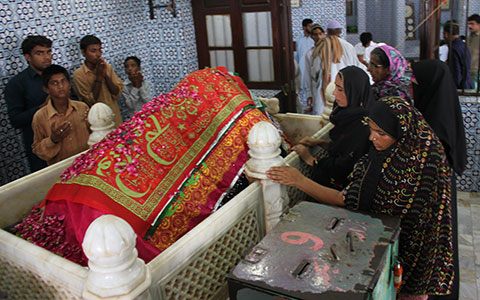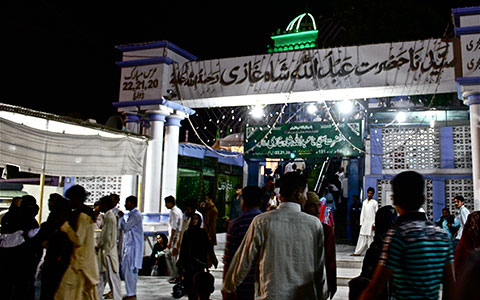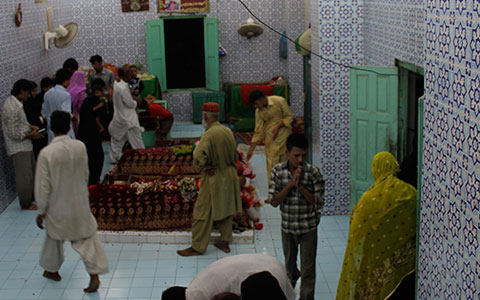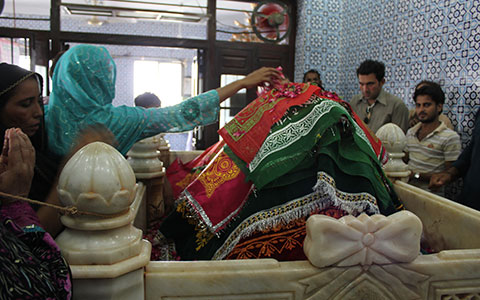Death and devotion
by - 18th July 2012

KARACHI: Pakistan’s biggest mela attracted thousands again this year despite increased violence against folk Islam worldwide.
The Urs or memorial event of the Sufi saint Lal Shahbaz Qalandar in Sehwan, Sindh took place last week as it has done for centuries.
Temperatures rose to fifty-one degrees centigrade, but devotees took no notice as they danced to beating drums, singing, smoking hashish, eating and praying at the tomb of the mystic. Women swirled in a trance-like state, caring very little about the public eye, the political drama unfolding in the country - or the threat of terrorist attacks.
Less than a month ago a bomb blast at a Sufi shrine in Peshawar killed three people, bringing the death toll to more than 108 in the last two years, with at least six different shrines bombed, and more than 367 people injured.
Forcing Shias and moderate Sunnis to stop such practices through physical violence was rare until recent decades, which have led to the creation of more militant factions within the Wahhabi or Deobandi groups.
A fierce, minimalist form of Islam, Wahhabism sprang up in the remote central highlands of Saudi Arabia in the eighteenth century under the guidance of Mohammed ibn abd al-Wahhab (1703–1792). For him, the fundamentals were enough: belief in the Quran and God, and there was no need for an intermediary. Asking a Sufi saint for guidance was blasphemy.
The mela in Sehwan is the largest in Pakistan, but similar festivities take place all over the country, from Karachi to Bhit Shah, and from Multan to Islamabad and Lahore.
This culture of celebrating the life of a Sufi mystic through an extravagant festival is a receding one. Until a few decades ago, these various urs melas (death anniversary festivities) would compose a calendar of their own, based around the Monsoon climate of the Seraiki belt. Many insist the festivals today encompass less than a fifth of the grandeur of those experienced by previous generations.
The tradition of Sufism incorporated parts of the local culture wherever it went in order to gain acceptance, making each country’s version unique. In India Sufis spread their philosophy through poetry or Qawwali – devotional songs. In Turkey it spread through dance and in other places through conversation. Even within a single country, Sufi rituals differ from region to region depending on local custom, and these distinctions are most visible during urs melas.

A few decades ago, millions of people would plan their year according to this festival calendar. Tens of thousands of industrialists would travel from festival to festival, setting up stalls to facilitate the Sufi melas, selling everything from clothes to cooking utensils to toys and food. The festival would involve not only music, but also local sports and a circus.
The central feature of the mela in Sehwan is the glittering shrine of Syed Usman Marwandi or Lal Shahbaz Qalandar, with its Sindhi tiles, mirror work, and magnificent gold-plated door, which was donated by the Shah of Iran.
Lal Shahbaz Qalandar is also revered in popular poetry and music, the most well-known being the song Dama’a Dam Mast Qalandar, sung by famous Qawwals Abida Parveen, Nusrat Fateh Ali Khan – a favourite at the WOMAD festival in Britain until his death - and the Sabri Brothers on separate occasions. He preached tolerance between Hindus and Muslims, and while he belongs to the Suhrawwardi order of Sufism, his devotees belong to both sects.
The Sufi orders of Islam followed in the Indian subcontinent are Chishti, Qadri, Suhrawwardi and Naqshbandi. The first three trace their origins to Hazrat (‘Respected’) Ali, who was the Prophet’s son-in-law, the fourth Caliph and also the first Imam of Shia belief. The Naqshbandi order traces its origins to Hazrat Abu Bakr, one of the Prophet’s companions, and the first Caliph.
This formed the basis of an ongoing argument about the sectarian exclusivity of saints. They were originally national saints, to be revered by people of all faiths, and during their lifetimes they not only stood by all oppressed people, but also preached tolerance between different religions.

When Islam spread to South Asia, it incorporated local custom, so much of the ritual in Shia processions, Sufi festivals, and even Islamic weddings signifies the inclusion of an aspect of Hinduism. Some fundamentalists among Wahhabis and Deobandis see this as idolatrous and resort to bombing and burning shrines.
Within the Deobandi movement there are two schools of thought, jihad through peaceful preaching, like the Tablighi Jamaat, and jihad through the sword, as with the Taliban.
The latter only adopted violent methods in the 1980s when Pakistan became the center of a proxy war. Local Shias began to receive inspiration and funding from Iran to take the revolution forwards, and Saudi Arabia did the same to counter this influence, which led to the rise in armed militant Deobandi movements.
The attacks against Barelvis are intensifying, and some Barelvis have begun to fight back in the form of the Sunni Tehrik, a political organization founded in the early 1990s. It aims to promote Barelvi interests and oppose Deobandi and Wahhabi sects. They oppose the appointment of important religious posts to Deobandis, and in the last five or six years they have also taken up arms against them.
According to Amir Mateen, a seasoned analyst on religion and politics in Pakistan, ‘Wahhabis essentially see Sufi beliefs of praying to a saint and visiting a shrine as grave-worshipping, and also see it as having an instrument to reach God, which is considered idolatry’.
Accusations of idolatry and unbelief (kufr) are not new. Abul Hassan Ali Hajvery, or Data Ganj Bakhsh the patron Saint of Lahore, complained in his famous eleventh-century treatise ‘Kashf al-Mahjoob’ of being labeled a Kafir by the puritanical clerics of his time.
His shrine was the target of a horrific bomb blast two years ago. However, with the installation of more security equipment and personnel, the annual mela still takes place, and this year the Punjab government released more than seven million rupees for free food and other arrangements for the festival. The three-day Urs begins with a shawl-laying ceremony at the shrine after the afternoon prayers.
Data Durbar is the oldest shrine in Pakistan and according to local myth, Data Ganj Bakhsh actually built the city of Lahore in the tenth century. He is so widely revered in Lahore that a popular joke goes that a man called from Mecca to ask a relative to pray for his health at Data Durbar.
Another shrine that was bombed in 2010 but still continues to host festivities is Baba Farid Ganjshakar’s Mazaar in Pak Pattan, Punjab.
According to Talat Aslam, a senior Editor at The News, ‘Life goes on and melas take place because it is so deeply rooted within people, who see it as an integral part of their religion and culture. In fact it raises the defiance level, people get scared initially but then they become fatalistic, they think well whatever has to happen will happen.’
The urs of Baba Farid Ganjshakar is celebrated for six days at the beginning of Muharram (first month of the Islamic calendar) every year. Every Thursday Qawwalis are held at the shrine after Maghrib (evening prayer) to welcome the holy day of Friday.
Nizamuddin Auliya, the famous Sufi saint of the Chishti order supervised the construction of this shrine. Its main feature is a magnificent silver door with gold inlay, called the Baheshti Darwaza and walking through it is believed to guarantee paradise. It is opened only during the annual Urs, and a few people are killed in a stampede each year.
Baba Farid was the first major Punjabi poet. His verse transcended religious boundaries and was even included in the Sikh Holy Book by Guru Nanak who would often visit Baba Farid’s shrine.
Many other urs melas and shrines are located in the Punjabi city of Multan, including the famous shrines of Shah Rukn-e-Alam’s shrine and Baha-ud-din Zakaria. Of the numerous other prominent shrines in Punjab, the most famous are Sultan Baahu’s in Shorkot, the UNESCO world heritage site Uch Sharif, Bari Imam in Islamabad, Mian Ameer’s, Madhu Laal’s and Mir Hamid’s in Lahore, and although Bulleh Shah the famous Sufi poet does not have a shrine to his name, there is a big mela for him in Kasur.

These shrines are testimonials to how Sufism transcends religious difference. At Madhu Laal’s shrine lies the tomb of a Muslim who wanted his beloved Hindu disciple’s name attached to his own. Mir Hamid’s shrine is split into a tomb and cremation-site as it is devoted to a Sikh saint who was revered by both Muslims and Hindus. These shrines are still visited by devotees of all religions, as are their urs melas.
The culture of Sufi melas is diminishing because of ethnic tension in some areas, and an increase in religious extremism in others. Most people are aware that Islamic tradition is being forced into a dichotomy of Shia practices and Sunni practices, leading to growing intolerance and inter-Sunni conflict.
The popularity of this year’s Sufi melas in Pakistan indicates how tenacious is the tradition, and eliminating it may become increasingly bloody to succeed.
- Log in to post comments
